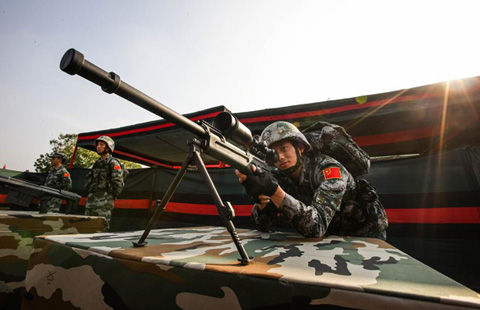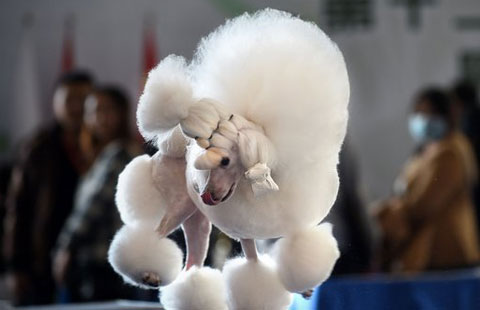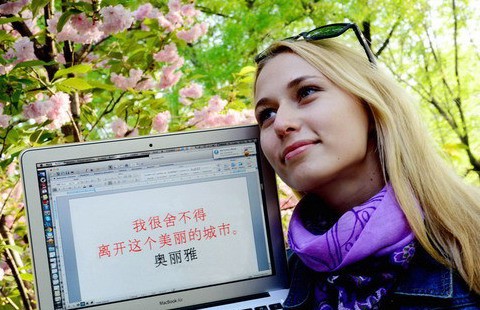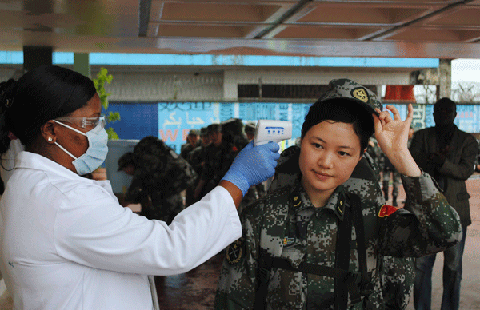
Researchers help shed new light on precious parts of shared WWII history between China and US allies, as Zhao Xu reports.
Barbara McMurrey, a 73-year-old from Texas in the United States, believes that her father, Major William McMurrey, still has a guiding hand on her, 70 years after his death.
"I was three when he was killed in 1944, during a fierce battle with the Japanese on the southwestern border of China," she said.
 |
|
Major William McMurrey (1910-1944) |
That was until about a decade ago, when Barbara had an early-morning dream.
"Unrolled before my mind's eye was a countryside view in the Orient," she said.
"Slightly bewildered, I saw a man with a buffalo walking slowly towards me ..."
A few years later, in the summer of 2005, Barbara was invited for the first time to China by a group of Chinese field researchers who told her that they had found her father's original burial place. It was in Tengchong, a small farm county in Southwest China's Yunnan province. While trekking on its muddy mountain trail toward her destination, she suddenly spotted a local villager and a buffalo.
"It was a Motherent of revelation: I was led to that place by my father, who's never left us," she said.
Deng Kangyan, 56, an amateur historian-and-documentary film producer, had played a major role in bringing that revelation to Barbara.
"For me, it all started with a black-and-white picture, which I got from the son of a village doctor in Tengchong. The old man, who had long gone, treated injured soldiers - both the Chinese and Allied troops - during World War II while operating a small backroom photo studio," he said.
"Most of the films sent to him for developing were from the Allied officers who had cameras. And the man made an extra copy of those which he deemed important. This was one."
The picture depicts a funeral: Under the silent gaze of a group of uniformed-clad soldiers, both Chinese and foreigners, a wooden coffin was being lowered into the grave. A huge banyan tree stood right behind them.
"It was one of the countless sad Motherents during WWII, taking place in Yunnan, part of what was known then as the China-Burma-India Theater (CBI) of the war."
Between the outbreak of the Pacific War on Dec 7, 1941, and the Japanese surrender on Aug 15, 1945, the Allied forces, mostly the Americans and British, joined Chinese troops to fight the invading Japanese, under arguably the harshest conditions encountered by any army during the war.
"The inhospitable subtropical climate, the seemingly unstoppable monsoon-season rain, the onslaught of the forests bugs, the scrub typhus that had claimed many lives, the enemy troops who, faced with their ultimate defeat, had gone all but crazy - for anyone who had been through these, the CBI experiences were absolutely unique and unforgettable," said Ge Shuya, an authority on that part of wartime history.
Bernard Martin knows all about it firsthand. In late August, the 93-year-old flew from his home in the US to Beijing to participate in the opening ceremony of a photo exhibition commemorating the Allied effort at CBI. All the images come from the National Archives and Records Administration in Washington, where Deng Kangyan and his team of seven had spent half a month in 2010 frantically recording everything that they could find related to China's WWII history, including photos and footage. The show was organized by the Shenzhen-based Yuezhong Museum of Historical Images.
While the machines of war roared in the background in the form of US airplanes and tanks, the overwhelming majority of the pictures on view spoke volumes about humanity. Combat personnel were caught in their non-combative Motherents, Motherents that revealed them as interesting and deeply interested humans ready to dive into a foreign culture.
A US sergeant was shown painting a watercolor of a tribal woman in the hills of Yunnan. In certain cases, feet were probably more nimble than fingers: The US soldiers, while outperforming their Chinese counterparts in an American football match, had found the mastery of chopsticks too daunting a challenge. In one particularly moving shot, taken on Oct 14, 1944, a Chinese man paused on the streets of a bomb-shattered Tengchong to obtain a light for his cigarette from a US Army sergeant.
All that does not mean war was less cruel than it sounds; in fact it was even more so, said Martin, who was delighted to discover his picture at the exhibition, one that showed him and a Chinese soldier inspecting each other's rifles near Nhpum in Burma.
"The Japanese got all the paths heavily guarded, so we chopped our own paths in the forests, with a hatchet. Remember: We were sneaky Americans," he said, with a mischievous smile.
"Once we raided a group of Japanese stationed in a Burmese village. There were around 800 of them and it was breakfast time. We came from their back. The Japanese, totally unaware of what's about to happen, were still in the river bathing: Some were completely naked while others were swathed in clothes," Martin said.
"We opened fire. The fighting continued for two hours and at the end of it, the bodies of the Japanese were floating down the blood-streaked river."
Martin, who called himself "a daredevil", belonged to the 5307th Composite Unit, whose 3,000 members were the only ground battle forces the US government had sent to CBI. A long-range penetration jungle warfare unit, it was more famously known as Merrill's Marauders, after its brigadier general, Frank Merrill. The general himself died in 1944, in the middle of the three-month-long battle for Myitkyina, a Burmese town-cum-airfield whose capture dealt a fatal blow to the Japanese army in Southeast Asia.
Martin took part in the battle but said he could not remember the walk to the airfield because "that's how beat we were after all that continuous walking and fighting. ... We arrived at the airstrip and started digging trenches. All of a sudden, all hell broke loose and a wall of lead from a thousand rifles came our way. I saw the officer who was with us go down and then I passed out."
It turned out that Martin had contracted scrub typhus, a problem that could have saved his life.
Resting place
Many men from the US Army were noncombatant personnel but had also died in CBI as a result of their decision to fight on the frontline together with the Chinese soldiers, Deng said. One place he has often visited is the Guo Shang (meaning "the loss of the nation") Cemetery in Tengchong, a cemetery built in 1945 in memory of the more than 9,000 people who died during the five-month battle to take Tengchong, between May and September 1944. Amid the seemingly endless rows of identical-looking gravel tombstones stands a slightly larger one made of white marble with the inscription "Lieutenant Kirk Schaible" and another thirteen men from the US Army.
"I saw it for the first time in 1995 and immediately wanted to find out who they were," Deng said. He enlisted the help of many prominent field researchers. But the search would not be possible without the help of one man: John Easterbrook, the grandson of General Joseph Stilwell, whose name is almost equivalent to the US aid to the Chinese war effort against the Japanese invaders.
Assigned to CBI as commander of the US forces, the four-star general led the retreat of his men from Burma to India, through dense forests on foot, before making an eventual comeback to take Myitkyina. Apart from his eldest son, his two sons-in-law also served in CBI. One of them is Ernest Easterbrook, the father of John Easterbrook.
"Chinese never forget a friend, never," said John Easterbrook, who was two days short of 6 when the general died on Oct 12, 1946. Through him, Deng and his team of history pursuers were able to put their hand on some files concerning the war dead that had previously been as rated "confidential" by the US military.
"We got all the names of the men - in fact there were 19 instead of 14 of them - for whom that memorial stone in the Tengchong cemetery had been erected," Deng said. "Determined to have a fuller picture, we set out contacting all the relatives of those men."
The news was passed around surviving veterans in the US, as well as the families of those who died. On July 4, 2003, US Independence Day, and one year after Barbara had her dream about East Asia, she received a message from a distant cousin that "someone from China is looking for us". It turned out that her father was also on that list.
For the first time since the death of their mother, Fae McMurrey, in 1996, Barbara and her younger sister, Beverly, reached for the correspondence between their parents, thick stacks of letters that had been kept by the bereaved woman in the bottom of her dresser drawer.
In one letter, sent to their mother the day after the death of Major McMurrey, Colonel John Stodter, the major's superior, wrote about the funeral they had had for the fallen man, at "a beautiful terrace on a mountainside shaded by a giant Banyan tree", with the colonel conducting the service. The description eventually reached the searching historians in China, and the heavy curtain on a long-buried piece of history was finally lifted.
"Everything described in that letter matched the black-and-white photograph we had, the one about the funeral. The colonel himself was also in the picture. It couldn't be a mere coincidence," said Deng, who took further steps to investigate the connection and dug out all the details.
Then came that hot summer's day in 2005, when the McMurrey sisters came to China, along with Shan Stodter, daughter of Colonel Stodter, who died in 1990. A small memorial was held and presided by Stodter, standing in the same position her late father once stood.
"The body of my father was taken back to our hometown in Texas in April 1949. But it's in Tengchong, China, where he had died and was first buried," Barbara said.
"Mother had been to the China-Burmese border in the '60s, in an effort to retrace the footsteps of my father, but couldn't enter China due to political reasons. For us, to be there is to fulfill what's probably the last wish of my mother, and to bring Father truly home."
Looking back
In 2010, when Deng and his team were working against the clock searching for relevant information in the National Archives in Washington, he was stunned - and somehow stung - by the staff's reaction. "They were so surprised that we were there," Deng said.
"One lady said to me, 'The files kept here about European WWII history have been looked through numerous times by their researchers, while the ones for the Chinese battleground have been simply sitting there collecting dust. I'm so happy that you have come.
"By looking into that overlapping history between China and her allied friends during WWII, we have not only paid belated respects to our foreign heroes, but have rediscovered some precious memory of our own," Deng said.
Not far away from the original memorial stone at the Tengchong cemetery, Deng and his field researcher friends have erected a new one, with the names of the 19 men carved on it.
After the death of Major William McMurrey on May 21, 1944, people discovered in the upper pocket of the 34-year-old a picture of his wife and two daughters, Barbara and Beverly.
"I was barely 5 months old when Father was killed. But I know now that he knew I existed, thanks to the work of my Chinese friends which eventually brought me to read all his letters to my mother," Beverly said.
"The fire of love he had kindled, on that beautiful land for a beautiful people, has never stopped burning."
Contact the writer at zhaoxu@chinadaily.com.cn
|
Taken on Oct 14, 1944, this picture from the National Archives and Records Administration in Washington shows a Chinese man on the streets of a bomb-shattered Tengchong in Southwest China's Yunnan province getting a light for his cigarette from a US Army sergeant. Provided to China Daily |
|
This file photo shows the funeral being held for Major William McMurrey in Tengchong. The black-and-white picture eventually led to the discovery of a long-buried story. |
|
US veteran Bernard Martin, 93, visits a photo exhibition, themed National Memories: China-US Collaboration during WWII on Aug 30 in Beijing. Wang Zhuangfei / China Daily |
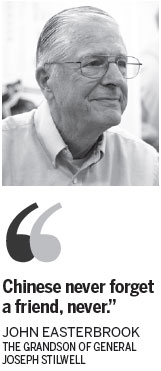
(China Daily 11/12/2014 page4)
